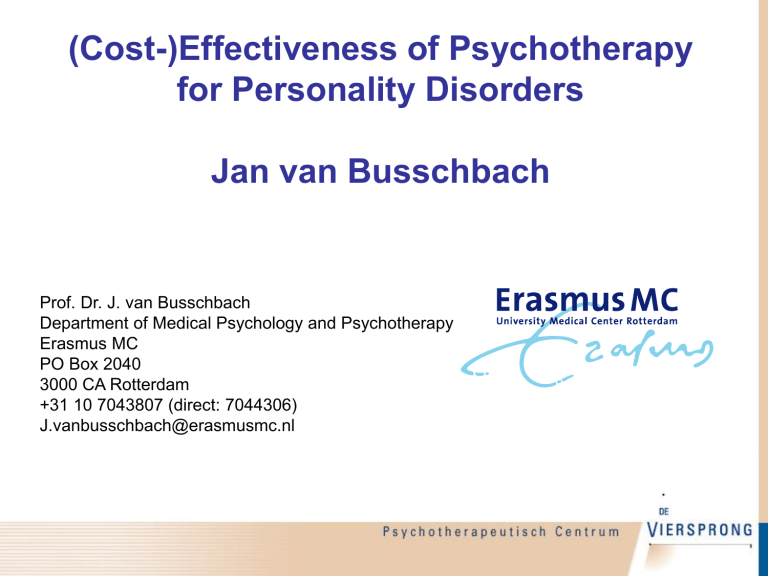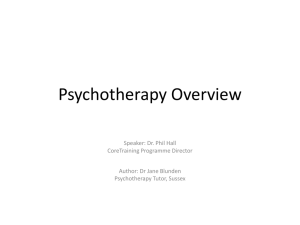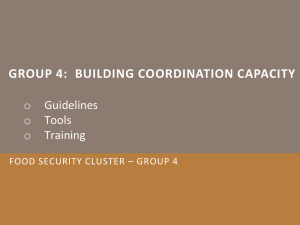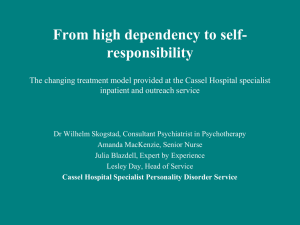(Cost-)Effectiveness of Psychotherapy for

(Cost-)Effectiveness of Psychotherapy for Personality Disorders
Jan van Busschbach
Prof. Dr. J. van Busschbach
Department of Medical Psychology and Psychotherapy
Erasmus MC
PO Box 2040
3000 CA Rotterdam
+31 10 7043807 (direct: 7044306)
J.vanbusschbach@erasmusmc.nl
Jan van Busschbach, Roel Verheul,
Anna Bartak, Djora Soeteman, Helene
Andrea, Janine van Manen
An different mindset:
Comparing “dosages”
Usually ...
– Comparison between theoretical orientation of therapy
Typically ...
– Amount of therapy is keep constant
– Little differences
• Nonspecific factors seems to drive treatment success
This assumes ...
– amount of therapy is relevant
Amount of therapy relates to costs
Yet ...
– Relation between costs and effects is rarely investigated
SCEPTRE
Study on Cost-Effectiveness of Personality Disorder
Treatment
Start: March 2003
6 clinics
SCEPTRE
About 900 patient with PD
Followed over 3 years
Dosages compared
– Outpatient, day-hospital and inpatient psychotherapy
– Shorter than or equal to 6 months, longer than 6 months
Clusters
– A; N = 58
– B; N = 241
– C; N = 466
Naturalistic design
Selection bias
Question to clinician:
– “What are the important variables for treatment allocation?”
Answer:
– “Everything is important!”
How to control for everything?
– “We are in need of a super covariate”
Correction for selection bias
Propensity score
– A sophisticated co-variance analysis
– Combines several co-variates
– To correct for baseline differences
If successful
– Results can be interpreted as an RCT
Several checks on validity
Often used in (health) economics
Super Covariate: the propensity score
Age
Sex
Diagnosis (SIDP-IV)
Baseline GSI
Motivation
Measures of pathology
– DAPP-BQ; SIPP; OQ-45
Quality of life (EQ-5D)
Is the super covariate valid?
Psychotherapy and
Psychosomatics, 2009
Separate PhD, 2010
Medical Care, 2010
Cluster A: one of the largest studies ever
Bartak, Andrea, Spreeuwenberg, Ziegler, Dekker, Rossum, Hamers, Scholte, Aerts, Busschbach,
Verheul, Stijnen, & Emmelkamp, (in press). Effectiveness of outpatient, day hospital, and inpatient psychotherapeutic treatment for patients with cluster A personality disorder. Under review
But assumptions are not met in cluster A
Assumptions met in:
3 groups in cluster B
– Inpatient
– Day-hospital
– Outpatient
5 groups in cluster C
– Short-term inpatient
– Long-term inpatient
– Short-term day-hospital
– Long-term day-hospital
– Long-term out-patient
Results cluster B
Bartak, Andrea, Spreeuwenberg, Ziegler, Dekker, Rossum, Hamers, Scholte, Aerts, Busschbach,
Verheul, Stijnen, & Emmelkamp. Effectiveness of outpatient, day hospital, and inpatient psychotherapeutic treatment for patients with cluster B personality disorder. Psychotherapy and
Psychosomatics, in press
But no significant results in cluster B…
Differences diminish till P = 0.06
– After correction with the propensity score
– Complicates conclusions
Assumptions of propensity score are met
– Effect are reduces after correction
But costs could make the difference…
Results cluster C
Corrected rsults C
Treatment group
Short day hospital
Long day hospital
Short inpatient
GSI - Difference score
Long outpatient
Short day hospital
Long day hospital
-0.0770
-0.1278
0.3035
-0.0508
0.3805** 0.4313**
Long inpatient -0.0030
0.0740
0.1247
* p < 0.05 ** p < 0.01 *** p < 0.001
Short inpatient
-0.3065*
Propensity escore in cluster C
Better effects of short-term inpatient psychotherapy remain significant
Assumptions propensity score are met
– Results maintain
But costs could still make a difference…
Conclusions: effects
No comparison possible in cluster A
– But psychotherapy seems to work
– Inpatient / day hospital seems better
Non difference in B (after correction)
– But costs can be decisive ….
Cluster C
– Favorable results for short-term inpatient psychotherapy
– Expect to dominates long in-patient
– But is short-term inpatient worth the costs?
• Compared to long day hospital / short day hospital
QALY
Health economics addresses the efficient allocation of health care resources
For instance
– Psychotherapy “long” versus “short”
– “Psychotherapy in PD” versus “Care for diabetics”
Make effects comparable
– Same effect parameter in diabetes as in PD
Survival and Quality of Life
Combined: Quality Adjusted Life Years (QALY)
QALY
Quality Adjusted Life Years
Area under the curve
1
0,9
0,8
0,7
0,6
0,5
0,4
0,3
0,2
0,1
0
0 10 20 30 40
Life years
50 60 70 80
20
Co-morbidity
With psychotherapy
No psychotherapy
EQ-5D
The EuroQol EQ-5D is specially designed to measure the quality of life index for QALYs
MOBILITY
– I have no problems in walking about
– I have some…….
– I am confined to bed
SELF-CARE
– I have no problems with self-care
– I have some problems…..
– I am unable…
USUAL ACTIVITIES
– I have no problems with performing my usual activities
– I have some problems…
– I am unable….
PAIN/DISCOMFORT
– I have no pain or discomfort
– I have moderate …..
– I have extreme……..
ANXIETY/DEPRESSION
– I am not anxious or depressed
– I am moderately……..
– I am extremely…..
21
22
Burden of disease: EQ-5D
Normal population
HIV
Schizophrenia (treated)
Diabetes II
Parkinson
Lung cancer
Personality disorder
Rheumatic disease
Heamodialysis
Major depression
0 0,2 0,4 0,6 0,8
Soeteman et al. Journal of Personality Disorders, 2008;22:259-68 .
Soeteman et al. Psychiatric Services, 56, 1153-1155, 2005
1
Markov model Cluster B
Soeteman, Verheul, Delimon, Meerman, Van den Eijnden, Rossum, Ziegler,
Thunnissen, Busschbach, Kim. Cost-effectiveness of psychotherapy for cluster B personality disorders. British Journal of Psychiatry 2010;196:396 –403.
Costs and effects in Cluster B
25
Interested in both costs and effect
High costs
Forget it!
Good
Better
Less effective
Difficult…
Superb!
Low costs (savings)
More effective
26
Forget it!
Sensitivity analysis
High costs
Good
Less effective
Difficult…
Superb!
Low costs (savings)
Better
More effective
27
Cost-effectiveness plane
€ 250 000
€ 200 000
€ 150 000
€ 100 000
Good
€ 50 000
€ 0
2,8 2,9 3,0 3,1 3,2 3,3
QALYs
3,4 3,5 3,6 3,7
Better
3,8 long out short day long day short in long in
28
0,2
0,1
0
0,5
0,4
0,3
1
0,9
0,8
0,7
0,6
Acceptability curve
Long outpatient
Short day hospital
Long day hospital
Short inpatient
Long inpatient
Societal WTP for a QALY (
€)
Cluster B
Out /
Day / in – patient
Cluster B
Out /
Day / in – patient
Cluster C
31
Soeteman, Verheul, Meerman, Rossum, Delimon, Rijnierse, Thunnissen, Busschbach, & Kim.
Cost-effectiveness of psychotherapy for cluster C personality disorders.
Journal of Clinical
Psychiatry (in press).
32
Cluster C
33
Conclusion
Cost-effective treatment strategies are:
Cluster C PD:
– Short-term inpatient psychotherapy (first choice)
– Short-term day hospital psychotherapy
Sub-optimal treatment options are:
– Long-term day hospital and long-term inpatient
Cluster B PD:
– Outpatient psychotherapy (first choice)
– Day hospital psychotherapy
Sub-optimal treatment option is:
– Inpatient psychotherapy
Dutch Council for Public Health and
Health Care (RvZ, 2006)
34
35
Definition “recovered patient”
Clinically significant change:
(Jacobson and Truax, 1991)
– Recovered: statistically reliable
+ ends up within normal limits
– Improved: statistically reliable
, but ends still dysfunctional
– Unchanged: no statistically reliable
– Relapsed or deteriorated: statistically reliable in the opposite direction
General Symptom Index (BSI/SCL-90)






